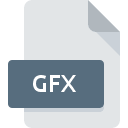.GFX File Extension

GFx Scaleform File
| Developer | Autodesk |
| Popularity | |
| Category | Game Files |
| Format | .GFX |
| Cross Platform | Update Soon |
What is an GFX file?
The .GFX file extension is associated with GFx Scaleform, a powerful middleware technology developed by Autodesk. These files contain graphical data used in various applications, especially in the realm of video games, user interfaces, and multimedia projects. GFx Scaleform provides developers with tools for creating highly interactive and visually appealing user interfaces using Adobe Flash and ActionScript.
More Information.
The .GFX file extension emerged as a result of the need for a standardized format to store graphical data created using GFx Scaleform. Initially, it was primarily used in video game development to render dynamic user interfaces, menus, and HUDs (heads-up displays) within games. Over time, its application expanded to include interactive multimedia projects outside the gaming domain.
Origin Of This File.
GFx Scaleform originated from the acquisition of Scaleform Corporation by Autodesk in 2011. Scaleform was renowned for its advanced user interface solutions in the gaming industry. Autodesk integrated Scaleform’s technology into its suite of software offerings, catering to game developers and multimedia creators.
File Structure Technical Specification.
.GFX files typically contain vector graphics, images, animations, and other multimedia elements created using Adobe Flash and ActionScript. These files are structured in a manner that allows for efficient rendering and playback within applications utilizing GFx Scaleform technology. While the exact technical specifications may vary based on the version of GFx Scaleform used, .GFX files generally adhere to standards compatible with Adobe Flash and related technologies.
How to Convert the File?
Windows:
- Use specialized software: Utilize applications like Adobe Animate or Adobe Flash Professional to open .GFX files and export them to common formats such as SWF (Adobe Flash) or vector-based formats like SVG.
- Convert within game development engines: If you’re working with a game development engine like Unreal Engine or Unity, you can import .GFX files and then export them in formats suitable for your project, such as textures or sprite sheets.
Linux:
- Emulation or compatibility layers: Employ compatibility layers like Wine to run Windows-based applications capable of opening and converting .GFX files. You can then utilize the same methods as in Windows.
- Custom solutions: Develop scripts or programs using cross-platform libraries like Qt or GTK to parse .GFX files and convert them to desired formats.
macOS:
- Use macOS-compatible software: Adobe Animate or similar software that runs on macOS can be used to open .GFX files and export them to alternative formats like SWF or vector formats.
- Integration with development platforms: If you’re using game development engines like Unity or Unreal Engine on macOS, import .GFX files into your project and export them in formats suitable for your application.
Android:
- Utilize development frameworks: If you’re developing an Android application using a framework like Unity, import .GFX files into your project and export them in formats compatible with Android, such as textures or sprite sheets.
- Custom conversion: Write scripts or tools within your Android development environment to parse .GFX files and convert them to formats suitable for your application’s needs.
iOS:
- Development platforms: Similar to Android, if you’re developing an iOS application using Unity or other frameworks, import .GFX files into your project and export them in formats compatible with iOS, such as textures or sprite sheets.
- Custom conversion: Develop scripts or tools within your iOS development environment to handle .GFX files and convert them to formats suitable for integration into your application.
Others:
- Platform-specific solutions: Depending on the target platform or environment, explore using platform-specific tools or libraries to handle .GFX files. This might involve developing custom converters or integrating with existing solutions tailored to your needs.
- Third-party services: Consider utilizing third-party services or tools that offer conversion services for various file formats. Look for options that specifically support .GFX files and provide conversion to your desired formats or platforms.
Advantages And Disadvantages.
Advantages:
- Cross-platform compatibility: .GFX files can be integrated into various platforms and software environments.
- Rich multimedia capabilities: Supports vector graphics, animations, and interactive elements.
- Familiar development environment: Created using Adobe Flash and ActionScript, making it accessible to developers familiar with these technologies.
Disadvantages:
- Dependency on proprietary technology: Requires GFx Scaleform middleware for rendering, which may entail licensing fees.
- Performance considerations: Rendering complex .GFX files may require significant computational resources.
- Limited support for newer technologies: As Adobe Flash becomes deprecated, there might be challenges in transitioning .GFX files to alternative platforms.
How to Open GFX?
Open In Windows
.GFX files can be opened in Windows using applications that support GFx Scaleform rendering, such as video game development engines like Unreal Engine or Unity, provided that appropriate plugins or integration tools are available.
Open In Linux
While there might not be native support for .GFX files in Linux, developers can explore using compatibility layers or emulation software to run Windows-based applications capable of rendering GFx Scaleform content.
Open In MAC
Similar to Windows, .GFX files can be opened on macOS using applications compatible with GFx Scaleform technology. This includes game development engines like Unreal Engine or Unity, which may offer macOS versions of their software.
Open In Android
.GFX files can be integrated into Android applications through development frameworks that support GFx Scaleform rendering, such as Unity or custom Android development using appropriate libraries and tools.
Open In IOS
iOS applications can incorporate .GFX files using development platforms like Unity or by leveraging native iOS development frameworks with support for GFx Scaleform rendering.
Open in Others
The ability to open .GFX files in other platforms or environments depends on the availability of software or development frameworks that support GFx Scaleform technology. This may include custom solutions or third-party tools tailored to specific requirements.













